
Plazas, promenades offer spaces to relax
SAN JUAN, P. R. — With about 80 percent of its tourists coming from cruise ships, visitors to Old San Juan often act like they’re in a rush to see as much as possible in one day.
The old city’s seven square blocks are framed by its city walls and two ancient forts on the east and west ends, Fort San Felipe del Morro and Fort San Cristóbal. Understandably, tourists in a hurry to visit these main attractions might overlook or only briefly visit the other areas of interest within the city.
But for those with time on their hands, Old San Juan’s promenades and more than 10 major plazas are great areas to relax and take in the sights of the city at a slower pace. Some of these walkways and parks, though, offer even more than just a spot to calm down and take a stroll or seat.
Paseo de la Princesa
At the south end of Old San Juan, near the piers and bordered by the old city wall is the Paseo de La Princesa. Unlike some of the plazas within the streets of Old San Juan, this promenade feels almost secluded, surrounded by an immense amount of foliage and greenery after its entrance that offers great shade from the often sweltering Caribbean heat.
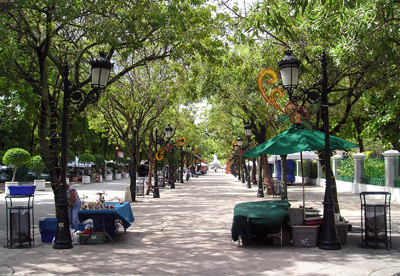 |
Paseo de la Princesa, teeming with vendors selling their wares to tourists on a weekend, leads to San Juan Bay in the distance (Photo by Rene Basulto). |
During most of the week, this area of the promenade is calm and ideal for sitting on one of its benches. Once the cruise ships enter on the weekend, however, vendors with tables and tents prop up to sell their wares of pieces of art and food.
Off in the distance where the trees end, you can see a fountain with a group of sculptures in the center, followed by San Juan Bay after you start walking down the path. The group of sculptures within the fountain is titled Raíces, Spanish for “Roots”, and it is meant to represent the influences that led to Puerto Rico’s cultural heritage.
Just before the fountain is La Princesa, a former prison built in 1837 and used up until 1960, which took its name from the walkway. Now, the building houses the offices of the Puerto Rico Tourism Co., along with a regularly changing art exhibit.
While this section of the Paseo de la Princesa may seem to be all there is, it would be a poor decision to ignore that the path continues onward past the fountain. This is the section is what makes the promenade so unique.
To your right is the city wall, and to your left is an amazing view of San Juan Bay. Lamps and benches line the rest of this portion, and trees extend overhead at the beginning. Eventually, after a turn to the right, the rest of the walkway comes into view.
The Paseo de la Princesa will continue up to the pier and the 40-foot high, red San Juan Gate, the very same gate that stood to protect the citizens of San Juan back in the 1700s.
It is here where the Paseo de la Princesa ends, but it’s also where Paseo del Morro begins. While the previous promenade had trees, benches, and a concrete barrier near the sea, this one is minimalistic, with the only things separating walkers from the water are the massive rocks found on some San Juan beaches.
Paseo del Morro was a maintenance road for workers attending to the west part of the walls surrounding San Juan, until it was converted into a trail in 1991. It extends all the way from San Juan Gate, to the western-most tip of Old San Juan towered over by both the city walls and the immense Fort San Felipe del Morro, more commonly known as El Morro.
| Paseo del Morro stretches between the old city walls and San Juan Bay, reaching all the way to Fort San Felipe del Morro (Photo by Rene Basulto). |
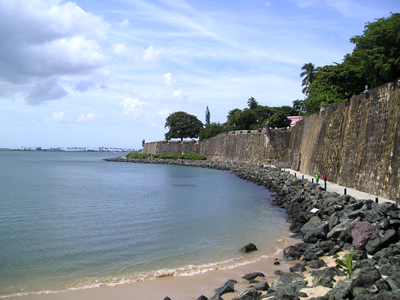 |
The walk there takes around 30 minutes, and with the lack of shade and exits, including at the end, it might be difficult for some during the hottest hours of the day. But those willing to make the trek will find the scenery incredible and the experience memorable.
“We like the connection between the sea and the historical monuments,” said Kaira Fuentes, who along with her father, Alfonso Fuentes, lives near San Juan. They had made their way to the very end of the path, which is a walk Kaira says they take often.
Alfonso, clad in a gray Los Angeles Lakers shirt drenched in sweat, said he enjoys because of the space and the feel of the waves hitting the rocks.
“It feels like an escape from the routine,” said Kaira.
From here, though, the only means of exit is to turn around and walk all the way back to the historic San Juan Gate. Those dreading a long walk all over again will be pleased to know that there are future plans to create an entrance to the path at El Morro. Even more ambitious, though, is the plan to extend the promenade all the way around the tip of Old San Juan and back towards the east to Fort San Cristóbal.
Plaza de Armas
Near the center of Old San Juan is the city’s first and main plaza, Plaza de Armas, which was built in 1521, the same year that San Juan was when it was originally called Puerto Rico, a name that eventually extended to the whole island. As the heart of Old San Juan, the plaza usually hosts everything from speeches to parades.
On weekdays, it is usually quiet with locals and tourists alike relaxing around the gazebo or standing in an immense flock of pigeons while they either feed or irritate them.
But on Saturdays, it comes alive with musicians playing guitars, and artist and artisans alike selling their works. One such artist is Ivelisse Pabon de Landron, who specializes in paintings and doll-making reflecting her mission to preserve the heritage of her African ancestors.
“I’m a descendant of a mother and daughter who were brought here in 1834 from Africa to work in the sugar plantation in Vega Alta, Puerto Rico,” said Landron, which is her theatrical name that she took from her ancestor’s slave owner’s name. She was born and raised in New York City, with a father of African heritage and a mother of Spanish heritage.
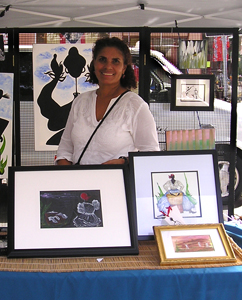 |
Ivelisse Pabon de Landron, a New York-born artist, sells her artwork at Plaza de Armas. Her paintings depict the African heritage of Puerto Rico (Photo by Rene Basulto). |
“Landron is my theatrical name, but [it] is also the slave owner’s name,” she explained. “So I take on my ancestor’s owner’s name to identify myself with [the fact] that they were brought here, that they lived on this plantation.”
Landron has a booth at Plaza de Armas twice a month, on the first and last Saturday. She says that there’s usually not much happening at the plaza during the week, unless there’s a festival such as the San Sebastian Art Festival, which takes place from Jan. 17 to Jan. 20.
Even with the amount of Puerto Rican culture displayed regularly there, Plaza de Armas is surrounded by several American stores and restaurants like Walgreens and Wendy’s that might be a sight for sore eyes for some homesick tourists. There’s an ATM nearby along with several pay phones in the center building of the plaza. But perhaps most importantly, the plaza is a great area to get picked up if you’re in need of a ride, as it is a hub for taxi cabs.
El Morro’s Esplanade
Though El Morro has several plazas surrounding it, the best place to relax might actually be on the fort’s esplanade. This wide-open empty field of green might have once been used as a strategic advantage that robbed enemy infantry of any cover from incoming fire, but now it is an excellent place to simply lie down in the grass.
While activities in the field range from student bands practicing on the grass to games of baseball being played, kite flying is the most common pastime. What makes this field ideal for kites is the strong wind coming in from the sea surrounding the fort. Some locals will even go out of their way to come fly kites at El Morro’s vast field.
Jessica Gusman, who lives in Guaynabo, a municipality west of San Juan, came to Old San Juan with her husband Gustave de Jesus, their daughter, Patricia de Jesus, and their niece, Gabriella de Jesus.
| The immense esplanade of El Morro, a favorite spot for kite flyers (Photo by Rene Basulto). |
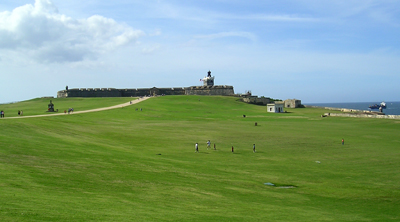 |
She says that she’s been coming to fly kites at El Morro for around 25 years, back to when she came at the age of four with her family. They would go every year, and she continues that tradition with her own family by coming to Old San Juan annually to fly kites and see the rest of the city.
What’s her suggestion for the best time of day to fly kites? After 3 p.m.
“Not too hot, but [the] sun’s still shining,” she said.
Locals tend not to bring their own kites, however, as there is a cart near the field that sells kites for around $4. These kites are good for about one use before they have to be thrown away, but they allow for anyone to enjoy kite flying, even tourists.
Cuartel de Ballajá (Ballajá Barracks)
Just across the street from El Morro’s field is a plaza with palm trees and a fountain adjacent to a large yellow and green building. While this plaza is perfectly fine for sitting on a bench and taking a rest, it is the building itself, the Cuartel de Ballajá that should draw more attention.
Built between 1854 and 1864 as barracks for Spanish infantry, the building now houses both the Museum of the Americas on its second floor, which showcases both art and artifacts relating to the Caribbean, and the headquarters of the Puerto Rico State Historic Preservation Office. What stands out the most about the Cuartel de Ballajá is the vast central patio overlooked by balconies that takes up most of the area.
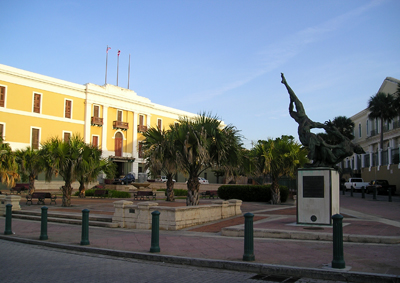 |
The Cuartel del Ballajá, lit by the afternoon sun, stands above its neighboring plaza, just across the street from El Morro (Photo by Rene Basulto). |
If You Go
Paseo del Morro is open from 6 a.m. to 10 p.m. daily.
If you are arriving from the piers, there is a trolley that runs, free of charge, to all of the attractions. Its stop near the piers is in front of Pier 2 on La Marina Street. Taxi cabs are also available from this area.
If you choose to walk from the piers, go west on La Marina Street until you reach Plaza de la Darsena, then go up the road and west on Comerico Street to reach Paseo de la Princesa. Paseo del Morro continues onward once Paseo de la Princesa finishes at San Juan Gate.
To reach Plaza de Armas, go to Paseo de la Princesa as stated above, and then go up the road next to the beginning of the city wall. Go west (left) on Recinto Sur Street, and then go north (right) on Cruz Street until you see Plaza de Armas on your left.
To reach El Morro from the piers by walking, go to Paseo de la Princesa as stated above, and then go up the road next to the beginning of the city wall. Go east (right) on Recinto Sur Street, then go north (left) on San Justo Street. Walk all the way up San Justo Street and, once it ends, go west (left) on Norzagaray Street. You will see El Morro on your right around where the street ends.
In a car, from Luis Muñoz Marín International Airport:
Take exit 26 (Baldorioty de Castro Avenue) going west. Take exit 25 (Muñoz Rivera Avenue) until you reach Old San Juan.
To reach Paseo de la Princesa, continue on Muñoz Rivera Avenue and make a left at Recinto Sur Street. Make a left at Puntilla Street, where you can park at La Puntilla Parking Lot to your right. This is right next to Paseo de la Princesa.
To reach Plaza de Armas, continue on Muñoz Rivera Avenue, make a right onto Norzagaray Street, and then make an immediate left onto San Francisco Street. After San Justo Street, you can park at La Cochera Parking Lot on your right. From there, continue walking down San Francisco Street to reach Plaza de Armas.
To reach El Morro, continue on Muñoz Rivera Avenue and make a right onto Norzagaray Street. Continue on this street, then make a left onto Morovis Street, where there is underground parking on your left.
Please be aware that driving in Old San Juan is not recommended due to very narrow streets and fairly limited parking.

Comments are Closed